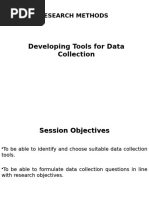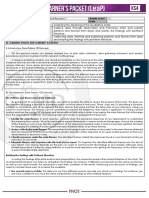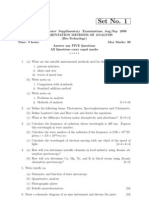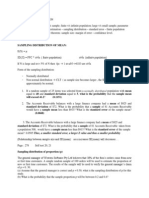3is Module 6 Lecture Notes
Uploaded by
Miks3is Module 6 Lecture Notes
Uploaded by
MiksName:______________________________ Section: _____________ Subject Teacher:_________________
3Is MODULE 6: FINDING THE ANSWERS TO THE RESEARCH QUESTIONS (QUALITATIVE)
Learning Objective: 1. The learner gathers and analyzes data with intellectual honesty using suitable
techniques
Activity 1: Assessment of Prior Learning
Directions: Encircle the letter of the best answer
1. Which of the following does NOT describe a qualitative data?
A. It uses statistical data.
B. Mostly non-numerical data like texts.
C. An exploratory way of finding the explanation of “how” and why of a certain event or phenomenon.
D. Collected through methods of observations, one-to-one interview, conducting focus groups and
similar methods.
2. It is a conversation between two or more people (the interviewer and the interviewee) where questions
are asked by the interviewer to obtain information from the interviewee following a structured
guidelines or pointers.
A. Individual Interview B. Observation. C. Questionnaires D. Vlog
3. It is used to analyze content from various sources, such as interviews of respondents, observations
from the field, or surveys. It focuses on using the stories and experiences shared by people to answer
the research questions.
A. Content B. Grounded Theory C. Narrative D. Thematic
4. Which of the following best describes qualitative data analysis?
A. It is an awkward, haphazard process.
B. It begins after all data has been collected.
C. It builds from abstraction to specific, concrete examples.
D. It is ongoing, cyclic process integrated into all phases of research.
5. Which of the following is NOT included in qualitative data preparation and analysis?
A. Getting familiar with the data
B. Revisiting research objectives
C. Identifying patterns and connection
D. Describing relationship between two variables
Developing Vocabulary
Term Definition
Qualitative approach -is an exploratory way of finding the explanation of “how” and “why” of a certain
event or phenomenon.
Qualitative data - is using mostly non- numerical data like texts, videos, and peoples written or
spoken words
Individual Interview - a conversation between two or more people (the interviewer and the
interviewee) where questions are asked by the interviewer to obtain information
from the interviewee following a structured guidelines or pointers
Questionnaires - series of questions and other prompts for the purpose of gathering information
from respondents
Observation - a group or single participants are manipulated by the researcher, for example,
asked to perform a specific task or action
- used made for their user behavior, user processes, workflow, etc. either in a
controlled situation example in the laboratory or in a real-world situation
example in the classroom
- deals with actual encounter with respondent particular activities of the day
Surveys open or close-ended questions
Themes - idea or categories that emerge from grouping of lowerlevel data points
Coding -process of attaching labels to lines of text so that the researcher can group and
compare similar or related pieces of information
Qualitative Data range of process and procedures whereby we move from the qualitative
Analysis (QDA) day that have been collected and procedures whereby we move from the
qualitative data that have been collected into some form of explanation,
understanding or interpretation of the people and situations we are
investigating
Page 1 3Is Module 5
Activity 2. Judge Me!
Directions: Read the following statements and decide if it is an example of Qualitative or Quantitative data.
______________ 1. The cake recipe requires 3 cups of flour.
______________ 2. The shelf life of the Papaya Pickle is 3 days.
______________ 3. Leonora earned 95% on her Math quiz.
______________ 4. The cloth of our table napkin feels rough.
______________ 5. The fish ball tastes sour.
COMMON WAYS TO ANALYZE QUALITATIVE DATA
1. Content analysis
This is one of the most common methods to analyze qualitative data. It is used to analyze documented
information in the form of texts, media, or even physical items. When to use this method depends on the
research questions. Content analysis is usually used to analyze response from interviewees.
2. Discourse analysis
Like narrative analysis, discourse analysis is used to analyze interactions with people. However, it
focuses on analyzing the social context in which the communication between the researcher and the
respondent occurred. Discourse analysis also looks at the respondent’s day-to-day environment and uses that
information during analysis.
3. Grounded theory
This refers to using qualitative data to explain why a certain phenomenon happened. It does this by
studying a variety of similar cases in different settings and using the data to derive causal explanations.
Researchers may alter the explanations or create new ones as they study more cases until they arrive at an
explanation that fits all cases.
4. Narrative analysis
This method is used to analyze content from various sources, such as interviews of respondents,
observations from the field, or surveys. It focuses on using the stories and experiences shared by people to
answer the research questions.
5. Thematic Analysis
In a thematic analysis of qualitative data, the researcher looks across all the data to identify some
recurring issues. Main themes that summarize all the views collected can be derived from these issues. The
main stages of thematic analysis are as follows:
A. Read and annotate transcript.
B. Identify themes
C. Develop a coding scheme
D. Coding the data
Read and annotate transcript.
In this stage, as a researcher you can have a feel for the data because primary observations are
provided. However, an overview of the data cannot be achieved in this early stage.
Identify themes.
In this stage, you can look at the data in details to identify themes. In each transcript, you may note at
the outset what the interviewee is trying to impart in his/her responses. It is suggested that these themes
must be enumerated, and notes be made as abstract as possible.
Example of a transcribed result of an interview conducted in Bulua National High School to displaced
learners during the Marawi siege. They were able to come up with varied theme depending on the questions
asked. This is a result based on one-on-one interview.
Page 2 3Is Module 5
Identifying Theme
If your research topic is using qualitative data, utilize the data you gather to develop and identify
theme. Otherwise, choose a topic relevant to your research and conduct an interview using the interview
protocol you learned in Practical Research 1. Follow the format of transcript of informant below. You may
limit your questions up to 5 or depending on the need of your research.
Develop a coding scheme. Initial themes can be collected to develop a coding scheme. This includes the
enumerated themes and the codes applicable to the data. Each broad code has a number of sub codes. It is
recommended to use a coding scheme as soon as initial data have been gathered.
Coding the data. The next step is applying these codes to the whole data set. This can be done on either the
margins of the transcripts or the statements in line. In an ideal setting, the whole set of data should be coded
to ensure honest and exhaustive analysis.
There are six basic steps in coding data:
a. Get an idea of the entire set.
After reading the transcriptions carefully, write down some ideas as they arise in the margins and
transcription.
Page 3 3Is Module 5
b. Select one interesting document.
Choose the shortest and perhaps the most interesting transcript, reread it and ask questions,
“What is the respondent talking about?” Discern the underlying meaning and jot down in the
margins of the transcript.
c. Start the document coding process.
Divide the transcript into segments, put brackets in each of the segments, and give specific code to
each phrase or word that exactly explains or describes the meaning of the text segment.
d. List all the code words.
After coding the whole text, look for redundant codes by grouping the similar ones. Through this
process, the list of codes can be reduced into a more manageable number. It is recommended to
limit the number of codes from the start of the process, so that it is easier to manage the reduction
of code number.
e. Review the list against the data.
Apply this preliminary organizing process to the same transcripts and find out if the new codes
appear.
f. Categorize the codes for emerging themes or descriptions of the subject or setting.
Themes or categories are the same codes combined together to identify major ideas in the data.
Identify five to seven categories representing the most discussed responses of the subjects. These
few themes will enable the researcher to write an in-depth information about a few themes, rather
than a broad description about many themes.
Developing a Coding Theme
Using the questions in your research data use the following steps in developing a coding theme. Use the
“How to Analyze Data and Use Codes or Categories” steps(Taylor-Powell and Renner 2003).
1. Get to know your data.
Read your data very well and have a good grasp of the meaning that each statement tries to
convey. Open-coding, the initial coding, is the process of examining data and finding themes that
are apparent (Strauss and Corbin 1990).
2. Focus the analysis.
Your participants might be giving pieces of information that are not related or significant to
your present study. Be sure to identify and disregard them.
3. Review the purpose and go back to the research question.
Always go back to the purpose of your study and your research questions. They will guide and
help you identify what is important and they are your main guides in analyzing your data.
4. Identify themes or patterns.
Use codes or labels, such as the one in the example given, during this process. Basically, we
use labels or highlighter to identify themes or patterns. Your thorough understanding of your data
will facilitate this process.
5. Ask team to analyze.
You can ask another person (your teammates) to reanalyze the data to make sure nothing is
missed during the open-coding.
6. Organize themes into categories: preset or emergent.
Once codes have been identified, you can now organize them in tabular form
7. Identify patterns within and among categories.
This is when you categorize patterns and themes that you have identified in your data. This
is the final step. You can further streamline your categories by looking at those that you think
could be combined to form just one category. Go back to your research questions. Those themes
and patterns that your have identified are the answers to your research questions.
Page 4 3Is Module 5
Activity 3. Creating a Theme
Complete the table. Think of possible preset codes/categories/themes for the given questions.
INTERPRETATION OF QUALITATIVE DATA
Interpretation of qualitative findings is a process of intellectualizing beyond the emerging themes to broader
perspectives of the data. In simple terms, interpretation of findings is making sense of the data collected, and
an act to identify the lessons learned from the study. In interpreting results, it is helpful to group similar
responses into categories then identify usual patterns to derive meanings from what may seem unrelated and
wordy responses. This strategy is very important in making sense of the outcomes of focus group discussions
and interviews. It must also be remembered that interpretation depends on the point of view of the
researcher.
Some Qualitative Data Analysis and Interpretation Tips
The following are some tips in analyzing and interpreting qualitative data that can be helpful to beginning
researchers:
Consider the data from various perspectives. Whatever the research may be or whatever data have
been collected, it is always best to ask what that data mean for readers.
Think beyond the data. Make the most out of the data, neither too much nor too little. Ensure that the
connection between or among the data sets and their interpretation are clear. Anchor all data
interpretations on the research objectives.
Make visible personal assumptions and beliefs or models that influence the interpretation,
representing personal views of the world. These models are usually not carefully analyzed and may be
below the level of understanding. If left unexamined, the assumptions and beliefs might lead to wrong
interpretations. Think and reason our carefully. Individual or collective listing of assumptions about
inquiry can be done.
In some cases, outlying data or data that is different from others may be encountered and regarded
accordingly. Consider to incorporate them in the analysis and interpretation data.
Watch out for some data may come in surprise, contradictory or puzzling, because they usually lead
to useful insights. They must also be given attention for a holistic interpretation of data
Page 5 3Is Module 5
You might also like
- SHS Inquiries Investigations and Immersion100% (2)SHS Inquiries Investigations and Immersion20 pages
- 1.analyzing The Meaning of The Data and Drawing ConclusionNo ratings yet1.analyzing The Meaning of The Data and Drawing Conclusion27 pages
- Senior High School Department: Practical Research 1No ratings yetSenior High School Department: Practical Research 17 pages
- Infers and Explain Patterns and Themes From Data100% (1)Infers and Explain Patterns and Themes From Data21 pages
- Finding The Answers To The Research Questions Lesson 1-Data Analysis MethodNo ratings yetFinding The Answers To The Research Questions Lesson 1-Data Analysis Method4 pages
- PR1 - Lesson 7 - Data Analysis ProcedureNo ratings yetPR1 - Lesson 7 - Data Analysis Procedure4 pages
- Data Collection and Analysis, Interpretation and Discussion100% (1)Data Collection and Analysis, Interpretation and Discussion76 pages
- Chapter IV Infer Patterns and Themes From The Gathered DataNo ratings yetChapter IV Infer Patterns and Themes From The Gathered Data43 pages
- Qualitative Data Analsysis - Thematic Analysis100% (1)Qualitative Data Analsysis - Thematic Analysis17 pages
- Research 1 Q4 Methods of Data CollectionNo ratings yetResearch 1 Q4 Methods of Data Collection11 pages
- Prepare and Organize Your Data. This May Mean Transcribing Interviews orNo ratings yetPrepare and Organize Your Data. This May Mean Transcribing Interviews or4 pages
- Grade: Self-Learning Module in PRACTICAL RESEARCH I Lesson100% (1)Grade: Self-Learning Module in PRACTICAL RESEARCH I Lesson8 pages
- Government College University Faisalabad: Assignment No. 3No ratings yetGovernment College University Faisalabad: Assignment No. 316 pages
- Kelompok 11 Mardhatillah Salabiayah Analyzing Action Research Data 6.2 What Is Data Analysis?No ratings yetKelompok 11 Mardhatillah Salabiayah Analyzing Action Research Data 6.2 What Is Data Analysis?3 pages
- Analyzing The Meaning of Qualitative DataNo ratings yetAnalyzing The Meaning of Qualitative Data2 pages
- Research Method BBA (201) Assignment WINTER 2014-2015No ratings yetResearch Method BBA (201) Assignment WINTER 2014-20158 pages
- III12 q1 Mod4 UnderstandingWaystoCollectData Abcdpdf PDF To WordNo ratings yetIII12 q1 Mod4 UnderstandingWaystoCollectData Abcdpdf PDF To Word14 pages
- Inferring and Explaining Patterns and Themes From DataNo ratings yetInferring and Explaining Patterns and Themes From Data26 pages
- Learning Area Grade Level Quarter Date I. Lesson Title Ii. Most Essential Learning Competencies (Melcs) Iii. Content/Core ContentNo ratings yetLearning Area Grade Level Quarter Date I. Lesson Title Ii. Most Essential Learning Competencies (Melcs) Iii. Content/Core Content4 pages
- (Emerson) Data analysis and interpretationNo ratings yet(Emerson) Data analysis and interpretation7 pages
- Quarter 4 Analyzing The Meaning of Dta and Drawing ConclusionNo ratings yetQuarter 4 Analyzing The Meaning of Dta and Drawing Conclusion77 pages
- Lesson 5 - Research Design and Methodology (Rev)No ratings yetLesson 5 - Research Design and Methodology (Rev)17 pages
- UAS Research On ELT II 2021 - Amalia Ikfi BillahNo ratings yetUAS Research On ELT II 2021 - Amalia Ikfi Billah4 pages
- Heidegger and Blumenberg On Modernity PDFNo ratings yetHeidegger and Blumenberg On Modernity PDF28 pages
- Do's and Don'ts in Review of Related LiteratureNo ratings yetDo's and Don'ts in Review of Related Literature1 page
- rr222304 Instrumentation Methods of AnalysisNo ratings yetrr222304 Instrumentation Methods of Analysis6 pages
- All Chapter Download Test Bank For What Is Life A Guide To Biology With Physiology, 1st Edition: Phelan100% (3)All Chapter Download Test Bank For What Is Life A Guide To Biology With Physiology, 1st Edition: Phelan45 pages
- BIOSTATISTICS AND RESEARCH METHODOLOGY.MURALI 007No ratings yetBIOSTATISTICS AND RESEARCH METHODOLOGY.MURALI 00713 pages
- Introduction To Tables and Graphs in SASNo ratings yetIntroduction To Tables and Graphs in SAS8 pages
- Analysis of Variance Analysis of Variance: Steps For One Way ClassificationNo ratings yetAnalysis of Variance Analysis of Variance: Steps For One Way Classification2 pages
- Factors Affecting Labour Productivity in Construction IndustriesNo ratings yetFactors Affecting Labour Productivity in Construction Industries4 pages
- Relevance in Science and Research, Research Integrity AND Intellectual Honesty100% (1)Relevance in Science and Research, Research Integrity AND Intellectual Honesty18 pages
- On A General Theory of Interpretation - The Betti-Gadamer DisputeNo ratings yetOn A General Theory of Interpretation - The Betti-Gadamer Dispute55 pages
- 1.analyzing The Meaning of The Data and Drawing Conclusion1.analyzing The Meaning of The Data and Drawing Conclusion
- Senior High School Department: Practical Research 1Senior High School Department: Practical Research 1
- Finding The Answers To The Research Questions Lesson 1-Data Analysis MethodFinding The Answers To The Research Questions Lesson 1-Data Analysis Method
- Data Collection and Analysis, Interpretation and DiscussionData Collection and Analysis, Interpretation and Discussion
- Chapter IV Infer Patterns and Themes From The Gathered DataChapter IV Infer Patterns and Themes From The Gathered Data
- Prepare and Organize Your Data. This May Mean Transcribing Interviews orPrepare and Organize Your Data. This May Mean Transcribing Interviews or
- Grade: Self-Learning Module in PRACTICAL RESEARCH I LessonGrade: Self-Learning Module in PRACTICAL RESEARCH I Lesson
- Government College University Faisalabad: Assignment No. 3Government College University Faisalabad: Assignment No. 3
- Kelompok 11 Mardhatillah Salabiayah Analyzing Action Research Data 6.2 What Is Data Analysis?Kelompok 11 Mardhatillah Salabiayah Analyzing Action Research Data 6.2 What Is Data Analysis?
- Research Method BBA (201) Assignment WINTER 2014-2015Research Method BBA (201) Assignment WINTER 2014-2015
- III12 q1 Mod4 UnderstandingWaystoCollectData Abcdpdf PDF To WordIII12 q1 Mod4 UnderstandingWaystoCollectData Abcdpdf PDF To Word
- Inferring and Explaining Patterns and Themes From DataInferring and Explaining Patterns and Themes From Data
- Learning Area Grade Level Quarter Date I. Lesson Title Ii. Most Essential Learning Competencies (Melcs) Iii. Content/Core ContentLearning Area Grade Level Quarter Date I. Lesson Title Ii. Most Essential Learning Competencies (Melcs) Iii. Content/Core Content
- Quarter 4 Analyzing The Meaning of Dta and Drawing ConclusionQuarter 4 Analyzing The Meaning of Dta and Drawing Conclusion
- How to Research Qualitatively: Tips for Scientific WorkingFrom EverandHow to Research Qualitatively: Tips for Scientific Working
- All Chapter Download Test Bank For What Is Life A Guide To Biology With Physiology, 1st Edition: PhelanAll Chapter Download Test Bank For What Is Life A Guide To Biology With Physiology, 1st Edition: Phelan
- Analysis of Variance Analysis of Variance: Steps For One Way ClassificationAnalysis of Variance Analysis of Variance: Steps For One Way Classification
- Factors Affecting Labour Productivity in Construction IndustriesFactors Affecting Labour Productivity in Construction Industries
- Relevance in Science and Research, Research Integrity AND Intellectual HonestyRelevance in Science and Research, Research Integrity AND Intellectual Honesty
- On A General Theory of Interpretation - The Betti-Gadamer DisputeOn A General Theory of Interpretation - The Betti-Gadamer Dispute

























































































